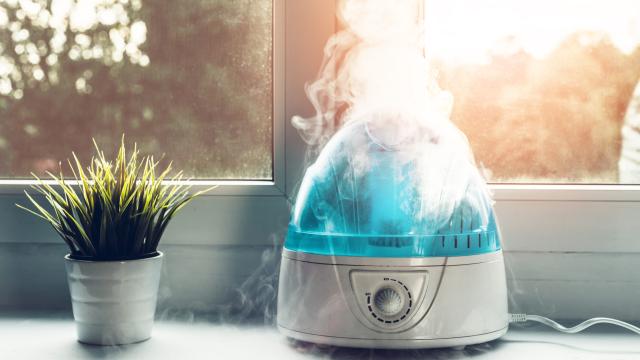Humidifiers can make breathing and sleeping more comfortable in the winter, giving off a gentle mist that can help with everything from dry sinuses and bloody noses to cracked lips and skin. But if you’re not cleaning your humidifier regularly, it can breed mould or bacteria, and make you feel worse — especially if you (or someone in your household) has asthma or allergies.
In fact, dirty humidifiers can make people sick even if they don’t have asthma or allergies. This is because breathing in air contaminated with bacteria and/or mould can cause flu-like symptoms or even lung infections, according to the Mayo Clinic. Here’s what you need to know about cleaning and disinfecting your humidifier so you can reap all the benefits without the gross stuff.
[referenced id=”705584″ url=”https://www.lifehacker.com.au/2016/01/the-best-type-of-humidifier-for-adding-bacteria-free-moisture-to-the-air/” thumb=”https://www.gizmodo.com.au/wp-content/uploads/sites/4/1970/01/01/705584_W0nmmHwtjjc-300×169.jpg” title=”The Best Type Of Humidifier For Adding Bacteria-Free Moisture To The Air” excerpt=”Humidifiers are great for adding moisture to the air in dry climates, but if they aren’t clean they can spew nasty bacteria into the air. Some humidifiers market themselves as “bacteria-free”, but only a few types of humidifier actually stay relatively clean.”]
Types of humidifiers
Though some homes have a central humidifier built into the heating and cooling system, the humidifiers we’re going to focus on here are the portable kind you can get at the drug store. There are several different types of those, including evaporative humidifiers (which blow air over a wet wick filter), steam humidifiers (which use electricity to create steam that cools before leaving the machine) and cool-mist humidifiers (which emit room temperature water). According to the Mayo Clinic, evaporators and steam vaporisers may be less likely to release airborne allergens than may cool-mist humidifiers.
How to clean a humidifier
First, check to see if your humidifier came with any specific operating and/or cleaning instructions that you should follow. If not, use this method — which was put to the test by the team at Better Homes and Gardens:
Supplies
- White distilled vinegar
- Soft-bristled brush or toothbrush
- Liquid chlorine bleach
- Water
Step 1: Take the humidifier apart
Unplug it, empty the water tank and detach any removable parts (including an air filter, if yours has one).
Step 2: Clean it
Pour enough white vinegar into the humidifier tank to cover areas that most often come in contact with water. Depending on the size of your humidifier (and how long you’ve gone between cleanings), you can also choose to dilute the vinegar with warm water for a less concentrated cleaning solution. Place smaller pieces, such as the tank cap, into a large container filled with vinegar to soak. Wait at least 20 minutes to allow the vinegar to break down any scale buildup.
After that, empty the humidifier and use a soft-bristled brush (a toothbrush works!) to clear away any debris or residue.
Step 3: Disinfect it
Mix 1 teaspoon of liquid chlorine bleach with 4 l of cold water, and fill the humidifier tank about halfway. Swish the solution around to coat the inside, then let it stand for 20 minutes. This should kill any lingering bacteria.
[referenced id=”797760″ url=”https://www.lifehacker.com.au/2018/08/we-put-a-humidifier-and-dehumidifier-in-the-same-room-and-made-them-fight/” thumb=”https://www.gizmodo.com.au/wp-content/uploads/sites/4/2018/08/15/797760_FfPs1SO_1Uc-300×169.jpg” title=”We Put A Humidifier And Dehumidifier In The Same Room And Made Them Fight” excerpt=”Video: “For my birthday I got a humidifier and a de-humidifier,” comedian Steven Wright used to say. “I put them in the same room and let them fight it out.””]
Step 4: Rinse and dry
Rinse each piece of the humidifier under running water several times until you can’t smell bleach anymore. Then let the parts air dry before you put the humidifier back together.
Clean your humidifier at least once a week while it’s in use, and then once (thoroughly) before putting it away for the season.

Leave a Reply
You must be logged in to post a comment.